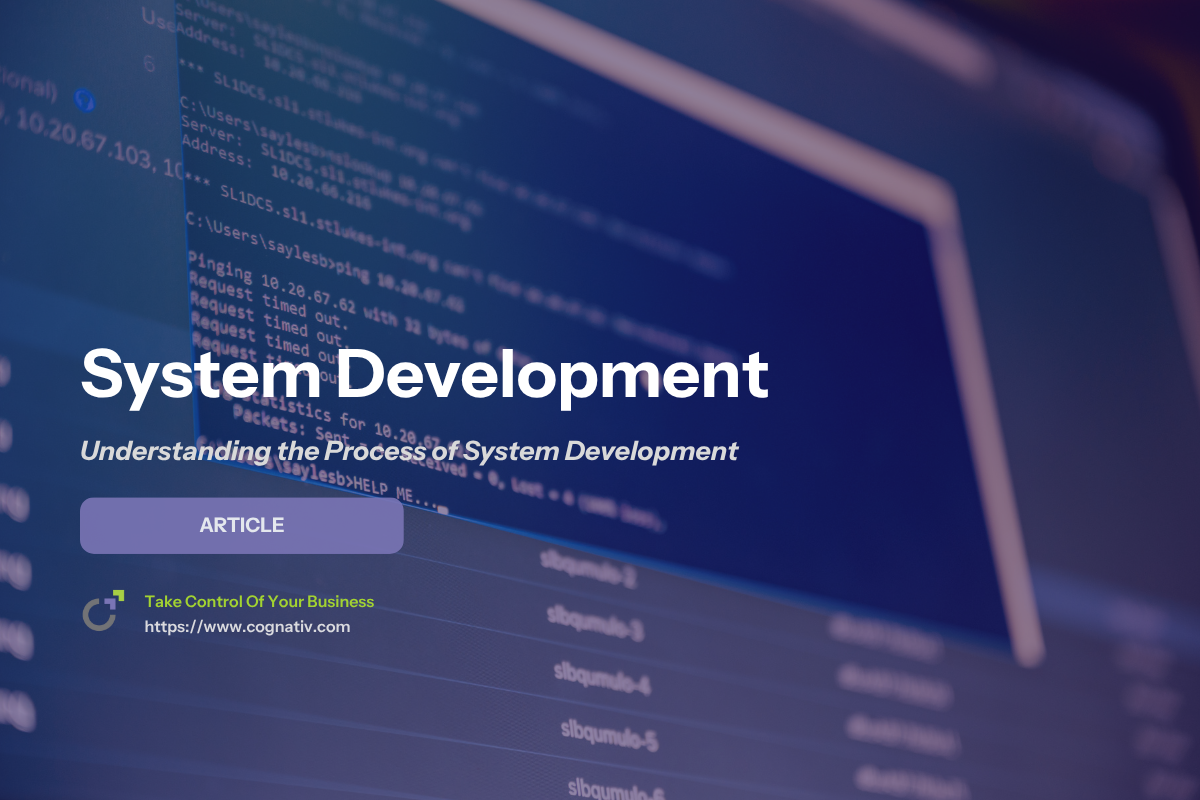Understanding the Process of System Development
The process of system development is essential for creating effective software. This guide covers each phase, from planning to maintenance, giving you the skills to manage development projects successfully.
Key Takeaways
-
The System Development Life Cycle (SDLC) provides a structured framework that guides software development from planning to maintenance, ensuring high-quality products that meet user expectations.
-
Key phases of the SDLC include Planning, Analysis, Design, Development, Testing, Deployment, and Maintenance, with each phase contributing significantly to the overall success of the project.
-
Incorporating methodologies such as Agile and DevOps enhances flexibility and encourages continuous improvement, making them suitable for projects with evolving requirements.
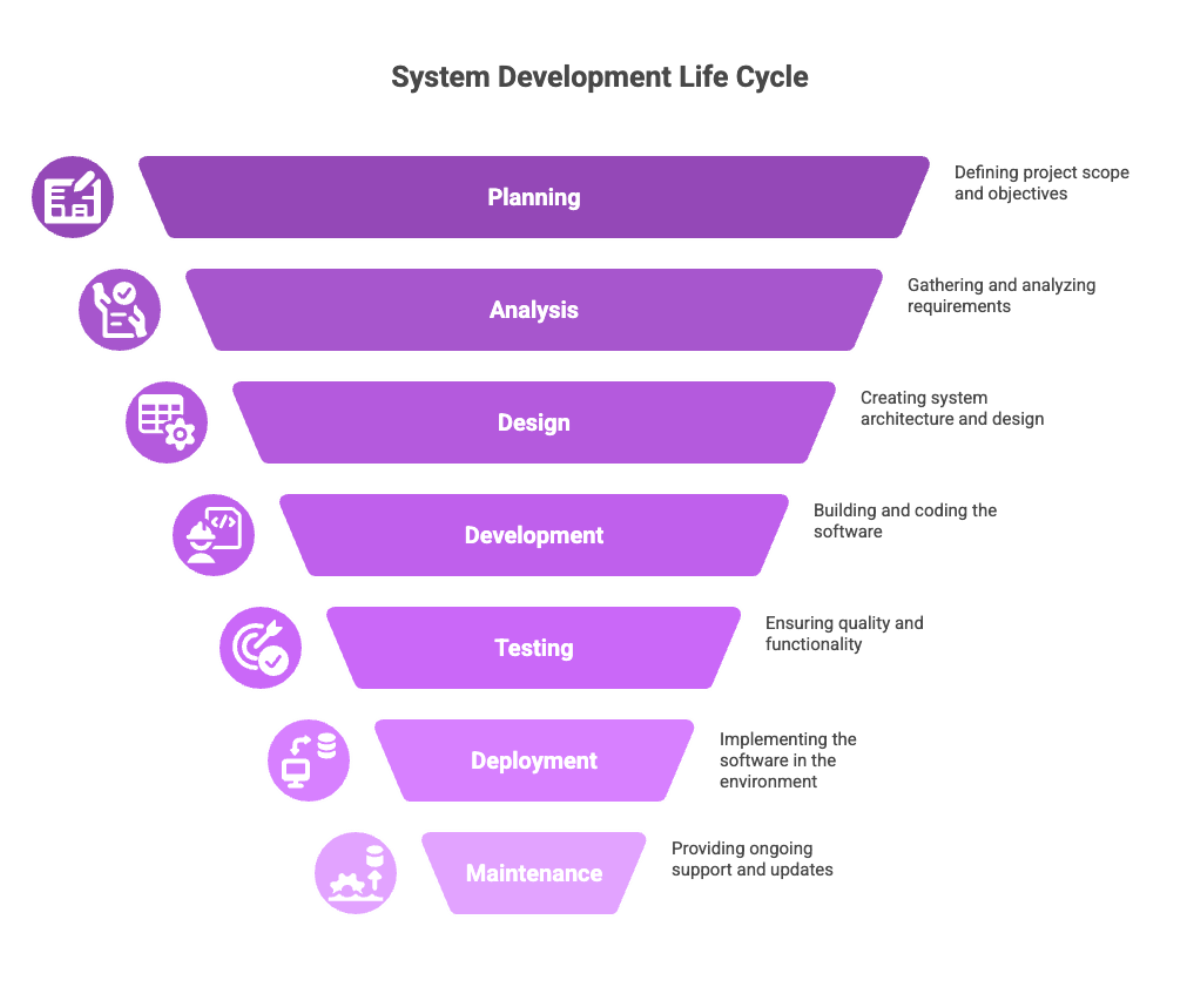

Understanding the System Development Life Cycle (SDLC)
The System Development Life Cycle (SDLC model) is a robust framework guiding the development process of software from inception to deployment and maintenance. At its core, the SDLC aims to deliver high-quality systems that meet or exceed user expectations, ensuring efficient resource allocation and timely project completion. SDLC methodologies help development teams reduce project failures, enhance communication, and optimize resource utilization.Formal SDLC methodologies are especially beneficial in large-scale projects involving numerous developers. A significant percentage of successful IT projects leverage these sdlc models to streamline decision-making and produce better-quality products.
Implementing SDLC practices can speed up development, cut costs, and unleash the creative potential of the development team, ultimately leading to the launch of high-quality software products.
Key Objectives of SDLC
The primary objective of the system development life cycle (SDLC) is to ensure that the final product meets both business and user needs. Efficient resource utilization, a clear framework for project management, and enhanced risk management are among the key goals of SDLC. A structured SDLC approach improves project organization, timeline management, and progress tracking, essential for project success. Additionally, quality assurance is embedded at each stage to ensure the final product meets or exceeds user expectations and industry standards.
Another critical objective is involving stakeholders throughout the development process. This not only ensures their needs are met but also aligns the project with the overarching business objectives. Identifying potential issues early on helps prevent costly errors, saving time and resources.
Inefficient requirements gathering is a common reason for software project failures, highlighting the importance of comprehensive requirement analysis. Ultimately, the SDLC methodology aims to enhance stakeholder satisfaction, minimize risks, and deliver high-quality software products.
Core Components of SDLC
The system development life cycle (SDLC) consists of several distinct stages that guide the system design life cycle of software. The system development process involves several key activities. These include:
-
Planning
-
Analysis
-
Design
-
Development
-
Testing
-
Deployment
-
Maintenance
Each stage plays a crucial role in ensuring a structured and systematic approach to system development.
The planning phase sets the foundation by defining problems and outlining project objectives, while the analysis phase focuses on gathering requirements and understanding user needs. The design phase transforms these requirements into detailed blueprints for the development team to follow.
During the development stage, the actual coding and assembly of the software take place. This is followed by the testing phase, where the software is rigorously tested to identify and fix any issues. Finally, the deployment phase involves releasing the software to users, and the maintenance phase ensures ongoing support and improvements.
Understanding these phases of the system is essential for successfully managing a system development project and delivering a high-quality product.


Planning Phase: Setting the Foundation
The planning phase is the cornerstone of any successful system development project. It involves defining the problems, outlining objectives, and setting the project scope. During this phase, project managers establish deadlines and time frames for each development stage, ensuring that the project remains on track and within budget, often using a separate project plan.
Resource analysis and feasibility assessments are also conducted to determine the project’s viability and ensure that the necessary resources are available for its successful completion. Engaging stakeholders early in the planning process helps align the project with business goals and keeps the project schedule on track.
Identifying Problems and Opportunities
Identifying problems and opportunities is a critical step in the planning phase. This involves gathering facts, diagnosing issues, and recommending changes to improve system outcomes. Common challenges in system development, such as security issues, must be addressed to ensure the system’s integrity. Management information systems play a vital role in this process.
Identifying stakeholders is crucial for comprehensive requirement collection, ensuring that all perspectives are considered. Tools that support systems development, such as project management suites and version control systems, enhance collaboration and efficiency, helping to keep the project on track.
Feasibility Study
Conducting a feasibility study is essential for assessing the project’s viability. This study evaluates operational, financial, technical, human, and legal/political aspects to determine whether the project can be successfully completed. Key activities in the preliminary analysis phase include conducting a thorough analysis, considering alternative solutions, estimating costs and benefits, and submitting a preliminary plan with recommendations.
Assessing these factors helps project managers identify potential challenges and determine the best course of action. This detailed planning helps ensure that the project manager is viable and sets the foundation for successful implementation.
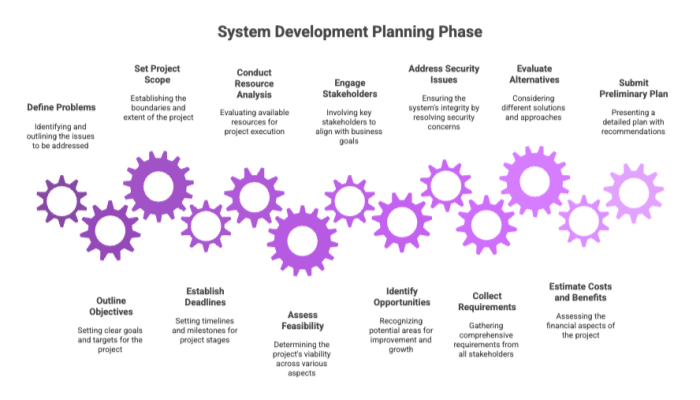

Analysis Phase: Defining Requirements
The analysis phase is crucial for defining the requirements of the system. It involves gathering requirements from stakeholders, conducting user interviews, and performing systems analysis to understand the problem domain. The goal of this phase is to determine where the problem lies and what needs to be addressed.
Techniques such as object-oriented analysis and design (OOAD), joint application design (JAD), and rapid application development (RAD) are used to gather and document requirements. Comprehensive requirement analysis can reduce mid-project changes significantly, ensuring that the project stays on track and meets user needs.
Requirement Gathering Techniques
Effective requirement gathering is essential for the success of any software development project. Techniques such as interviews, surveys, and workshops help extract accurate requirements from users. Recognizing problems early allows teams to prioritize solutions that align with business goals.
Clearly documenting requirements is a prerequisite to avoid confusion and ensure that expectations are met with the final product. This iterative process ensures that the development team has a clear understanding of what needs to be built, reducing the risk of project failures.
Creating the Software Requirements Specification (SRS)
The Software Requirements Specification (SRS) is a crucial document produced during the analysis stage of the SDLC. It serves as a definitive guide outlining both functional and non-functional requirements necessary for software development. Clear documentation of requirements in the SRS helps to avoid misunderstandings during the development process and ensures that the software meets user needs.
This document is vital for guiding the development team and ensuring that the final product aligns with the entire project goals and specifications.
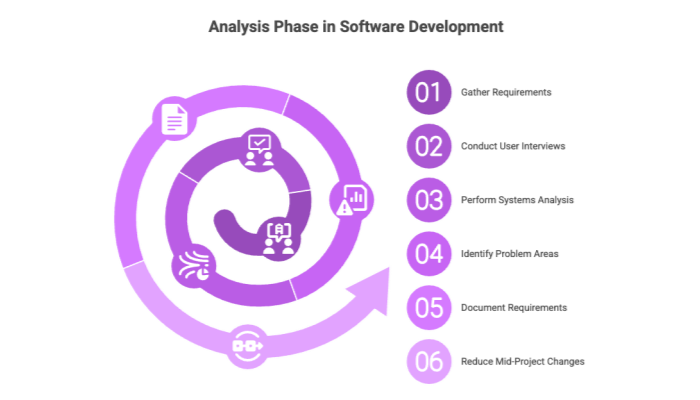

Design Phase: Crafting the Blueprint
The design phase is where the system’s blueprint is crafted, transforming requirements into detailed designs and prototypes. This phase focuses on creating a structured system design that guides the implementation phase. Key areas covered in the design phase include system architecture, user interfaces, and security protocols.A detailed design document is prepared, outlining critical design elements and ensuring that the final product meets user expectations. A well-documented design phase can result in significantly fewer defects in the final product, improving reliability and user satisfaction.
System Architecture Design
System architecture design involves creating the overall structure of the software, including database design, user interface layouts, systems design integrations, and the final system. Typical documents created during this stage include functional hierarchy diagrams, screen layouts, business rules, process diagrams, pseudo-code, and data models.
Detailed specifications define the system specifications’ hardware and software interactions, ensuring that all components work seamlessly together. These technical project specifications are essential for guiding the development team and ensuring that the final product meets the project requirements.
User Interface Design
User interface design focuses on creating intuitive and engaging interfaces that align with user expectations for better usability. The primary goal of user interface design is to enhance usability by meeting user needs and expectations. This involves designing user interfaces that are easy to navigate and interact with, ensuring that users can effectively use the system.
The design phase ensures that the user interface is both functional and aesthetically pleasing, contributing to the overall success of the software project.
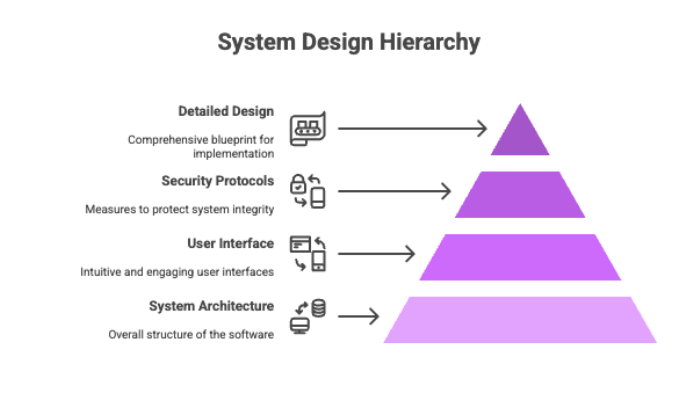

Development Phase: Building the System
The development phase is where the actual coding and assembly of the software take place. During this phase, the development team transforms design documents into a working system, ensuring that all functionalities are met. Adhering to design documents is vital for maintaining quality and ensuring that the final product meets user expectations.
This phase is crucial for building a system that aligns with the project requirements and delivers a high-quality product to users, following the previous phase of the upcoming project.
Coding Standards and Practices
Adhering to coding standards is crucial for ensuring that the code remains understandable and maintainable over time. Coding standards serve as guidelines for writing code, helping to create a consistent coding style. These standards ensure that the code is of high quality, easy to debug, and maintainable by other developers.
Quality assurance practices such as unit testing are also implemented to verify that the code meets the project requirements and functions as expected, following a verification and validation model.
Tools and Technologies Used
The development phase often utilizes various tools and technologies to build the software. Common programming languages used during this phase include C++, PHP, and others. Development activities also involve using tools such as compilers, version control systems, and project management suites to enhance collaboration and efficiency.
These tools and technologies are essential for ensuring that the software creation is built correctly and efficiently.
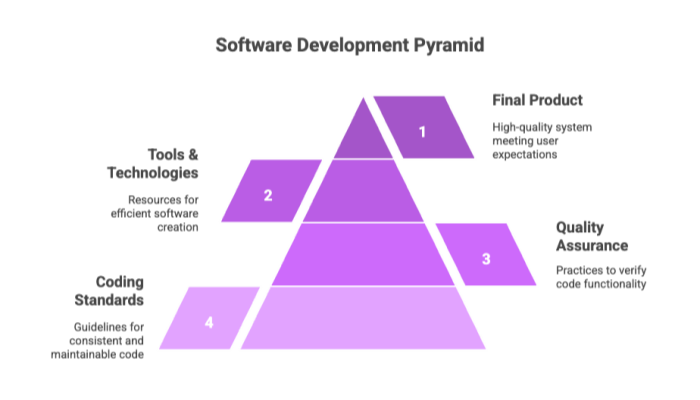

Testing Phase: Ensuring Quality
The testing phase plays a vital role in detecting errors introduced during development and ensuring that the software meets specified quality standards. Thorough testing can reduce post-release defects significantly, leading to more reliable software. Factors affecting the duration of the testing phase include developer skill, software complexity, and end-user requirements.
The purpose of final testing before product deployment is to ensure readiness for market presentation.
Types of Testing
The testing phase consists of multiple testing types. This includes everything from unit tests to user acceptance testing and system testing. The goal of thorough testing in system development is to identify defects early and ensure quality. During the testing stage, the software must meet the quality standards defined in the SRS document.
Integration testing checks for errors, bugs, and interoperability issues to ensure that all system components work seamlessly together.
Testing Tools and Automation
Automated testing platforms significantly reduce manual time in the testing process. Tools such as Selenium are popular for automated testing, helping to identify issues early and ensure quality. Behavior-driven development enhances testing by including non-developers through outcomes based on plain language.
Automated monitoring tools are also commonly used during the maintenance stage for quality assurance.
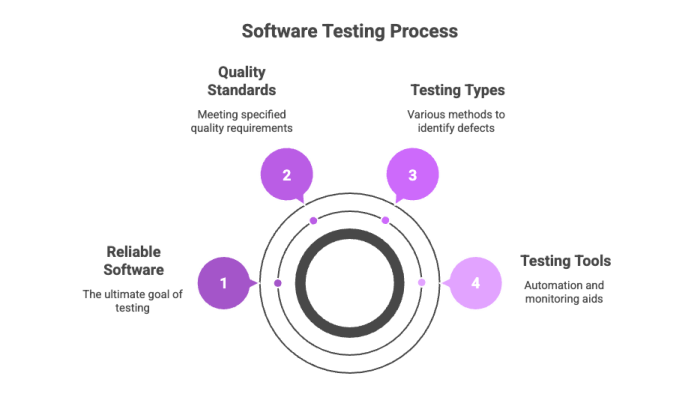

Deployment Phase: Launching the System
The deployment phase is a critical stage in the system development life cycle (SDLC) where the developed system is transitioned from a development environment to a production environment. This phase includes preparing the production environment, integrating the information system, and ensuring that all components are correctly configured for optimal performance.
Structured deployment processes can reduce go-live issues significantly, highlighting their importance in the deployment phase. User training and support are also essential during this phase to ensure that users can effectively utilize the new system.
Preparing the Production Environment
Setting up the production environment involves configuring hardware, software, and network settings for optimal performance. This includes implementing rollback protocols and feature toggling as contingency measures to handle potential issues during the product release.
A canary release, which allows for a limited initial release of the product, can facilitate a controlled deployment and help detect any remaining errors or defects. Ensuring that the production environment is properly prepared is crucial for a successful system deployment.
User Training and Support
User training is vital for ensuring that users can effectively utilize the system after deployment. This often includes interactive sessions that allow end-users to practice using the system in a controlled environment. Providing ongoing support post-deployment, such as helpdesk services and resources for troubleshooting, is also essential.
Acceptance testing verifies if the software meets user requirements and identifies potential issues before the public release, ensuring a smooth transition to the new system.
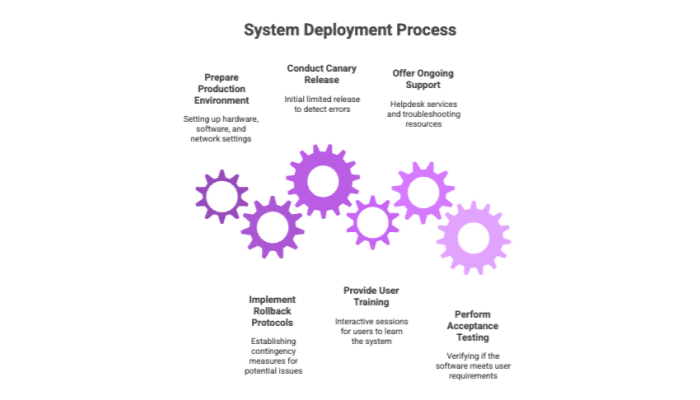

Maintenance Phase: Ongoing Support and Improvement
The maintenance phase is essential for ensuring that the software continues to meet user needs and adapts to changing requirements. During this phase, developers address issues that arise, such as residual bugs and new issues reported by users. Ongoing support focuses on monitoring performance, addressing feedback, and implementing necessary changes to keep the software relevant and efficient.
Early detection of issues helps prevent significant errors and saves time and resources during the maintenance phase.
Handling Bugs and Issues
Effective issue management during the maintenance phase involves prioritizing bugs based on their impact on users and system performance. Issues that may arise include residual bugs not patched before launch and new issues reported by users.
Promptly addressing these issues ensures that the software remains functional and meets user expectations.
Regular Updates and Upgrades
Regular updates are necessary to maintain the system’s relevance and effectiveness, adapting to changing requirements and protecting against risks. Factors such as continued operational need and system performance matching are assessed when considering updates. Periodic updates enhance system functionality and ensure security against emerging threats.
Failure to implement regular updates may lead to performance degradation, increased vulnerabilities to security threats, and user dissatisfaction.
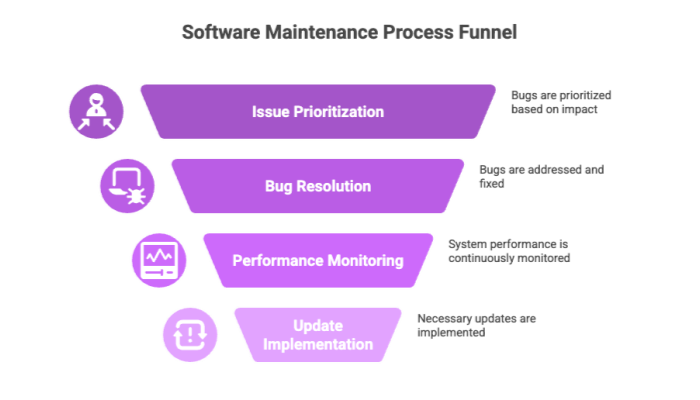

Alternative Approaches to System Development
Several methodologies have been developed for system development, including Waterfall, Agile, and incremental models. The choice of an appropriate system development life cycle model can significantly impact project success.
While traditional models like the waterfall model follow a rigid sequential approach, modern methodologies such as Agile emphasize flexibility and continuous improvement. Understanding these alternative approaches allows project managers to choose the best project management model for their specific project needs.
Agile Methodology
Agile methodology prioritizes fast and ongoing release cycles in software development, focusing on flexibility and continuous improvement throughout the software development process. The agile model emphasizes iterative development and continuous feedback from users, enabling ongoing collaboration and quick adjustments based on user feedback.
Teams using Agile work in short sprints, delivering functional software incrementally, making it best suited for projects with evolving requirements or where rapid delivery is crucial.
DevOps Practices
DevOps methodologies are popular approaches to system development that focus on continuous integration and delivery, particularly beneficial for projects requiring frequent updates and releases. DevOps integrates development and operations to enable continuous delivery of system updates, significantly impacting the System Development Life Cycle (SDLC).
Continuous integration involves automatic building and testing of software after changes, helping to identify issues early and ensuring a seamless development process.
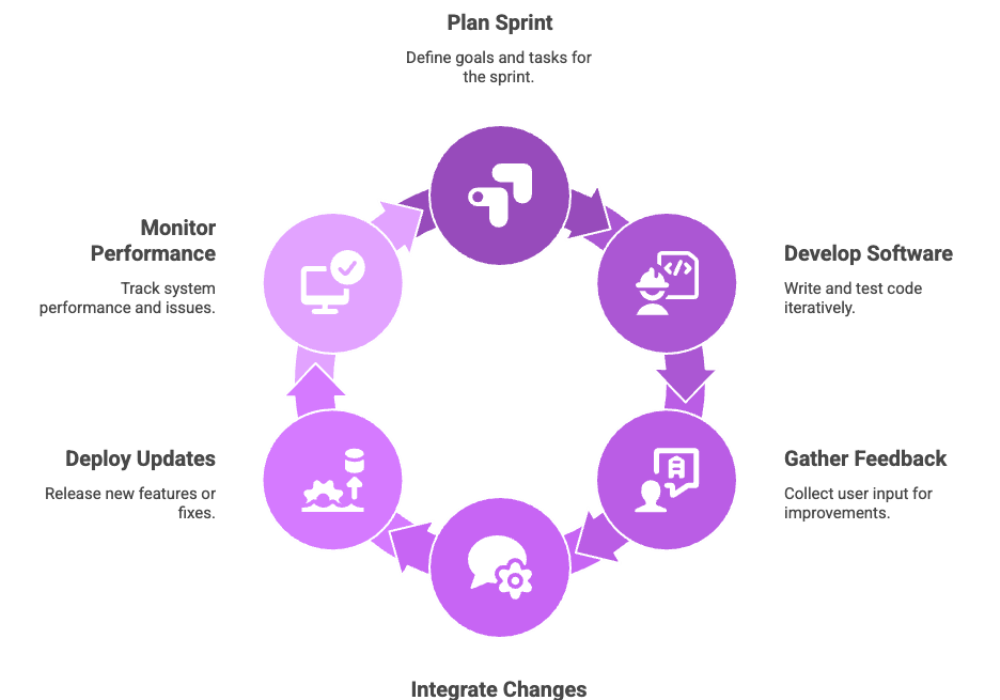

Summary
The System Development Life Cycle (SDLC) is a comprehensive framework that guides the development of high-quality software from concept to deployment and maintenance. By understanding and implementing each phase of the SDLC, from planning and analysis to design, development, testing, deployment, and maintenance, development teams can deliver software that meets user needs and business objectives.
Alternative approaches like Agile and DevOps offer additional flexibility and efficiency, highlighting the importance of choosing the right methodology for each project. Embracing these practices ensures the successful launch of high-quality systems that stand the test of time.

Frequently Asked Questions
To help you better understand the process of system development and the system development life cycle (SDLC), here are answers to some of the most common questions. This FAQ section covers key concepts such as the software development life cycle, planning stage, system operation, and the roles of systems engineers, providing clear insights into each phase of the development process and how they contribute to successful system implementation.
What is the primary purpose of the System Development Life Cycle (SDLC)?
The primary purpose of the System Development Life Cycle (SDLC) is to ensure the efficient delivery of high-quality software that meets user needs through a structured development process from planning to maintenance.
Why is the planning phase important in the SDLC?
The planning phase is essential in the SDLC because it establishes clear objectives and defines the project's scope, ensuring that resources are effectively managed and the project stays within budget. This foundational step is vital for guiding the subsequent phases of development.
How does the analysis phase contribute to the success of a software project?
The analysis phase is crucial for the success of a software project as it involves gathering and documenting requirements, ensuring that the final product aligns with user needs and project goals. This foundational understanding significantly reduces the risk of misalignment and enhances overall project effectiveness.
What are the benefits of using Agile methodology in software development?
The benefits of using Agile methodology in software development include rapid and continuous release cycles, iterative development, and the ability to quickly adapt to user feedback, making it well-suited for projects with changing requirements.
How do DevOps practices enhance the System Development Life Cycle (SDLC)?
DevOps practices significantly enhance the System Development Life Cycle (SDLC) by enabling continuous integration and delivery, which allows for early identification of issues and a more seamless development process. This integration of development and operations fosters efficiency and improves overall software quality.

